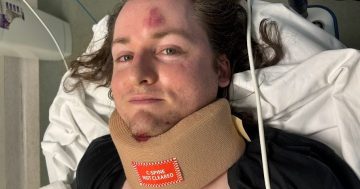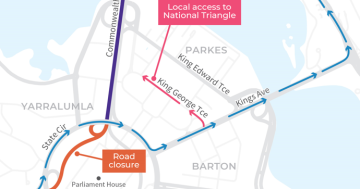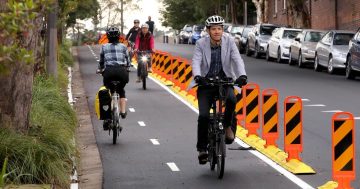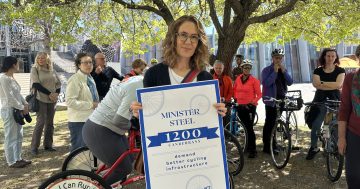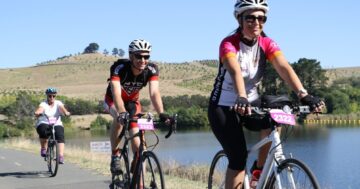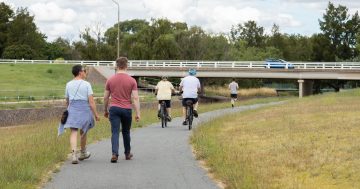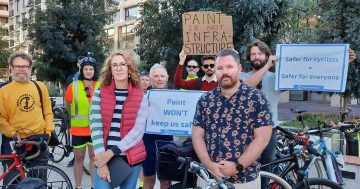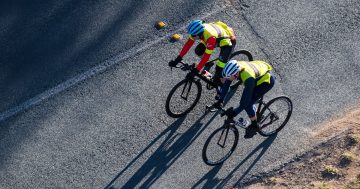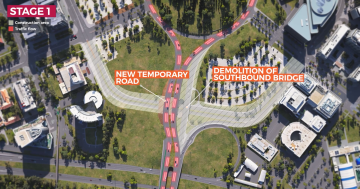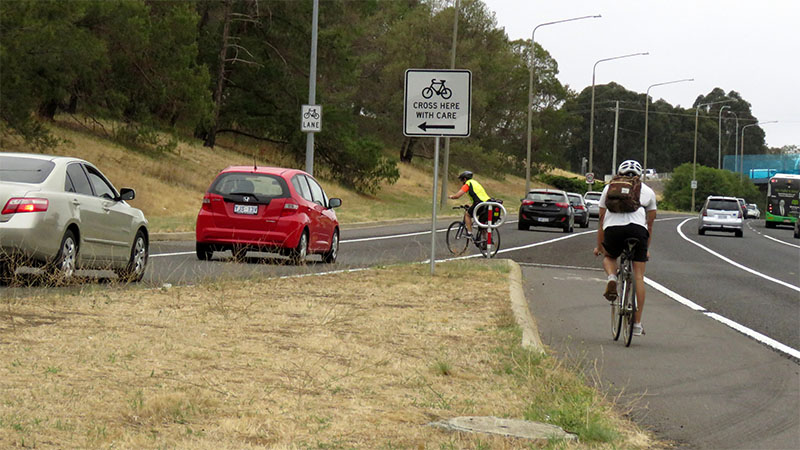
The Cotter Road-Adelaide Avenue junction is a danger point for cyclists. Photo: Pedal Power.
More work needs to be done to separate vehicles and bicycles and other active travel modes on major roads such as the Cotter Road and Adelaide Avenue, according to the Inner South Canberra Community Council.
In its submission to the ACT Government on its Active Travel Plan released in July, the council says keeping bicycles, scooters and other means of transport away from motor vehicles to increase safety should be a priority.
The council says the increasing volume of traffic along the Cotter Road/Adelaide Avenue corridor to Canberra Avenue from the rapidly growing Molonglo Valley posed safety issues for those wanting to cycle or otherwise to and from the city and Inner South.
It says Cotter Road should be prioritised for active travelling upgrades, extending through to the intersection with Adelaide Avenue and connected to Canberra Avenue.
“Routes such as Adelaide Avenue provide little separation between vehicle, cycle and pedestrian modes and this is a major obstacle to its use, especially for commuters to and from the city,” the submission says.
“Quick build treatments to test design solutions should be prioritised for these primary commuter routes.”
Some of the newer bike paths and lanes have concrete barriers separating them from the roadway.
The submission says now is the time to plan the needed infrastructure along the city’s main routes, particularly in the south where the next light rail extension is expected.
“Development of Light Rail Stage 2B will have a significant impact on Deakin and other inner south areas,” the submission says.
“Now is an ideal time to develop viable active travel routes that can be incorporated efficiently into future transport network design and provide a timely response to light rail disruption.”
In 2020, cycling lobby group Pedal Power proposed separated cycleways within the road/rail corridor as part of early planning for active travel arrangements in the context of light rail to Woden.
The council is also concerned about the impact the increasingly popular electric scooters are having on shared paths, and wants a dedicated safety campaign.
It says residents have raised safety issues, particularly on paths around shopping and town centres and where overhanging shrubbery near driveways obscures the view of pedestrians and scooter riders and cyclists.
“Even though education activities are referred to in the plan, we consider that a separate action could be added on, rolling out safety education campaigns whilst ‘bedding down’ this (still relatively) new addition to our active transport options,” the council says.
The council says ‘right-of-way’ rules should also be developed and enforced to make shared paths safer, and Access Canberra should monitor illegal parking, erect bollards where necessary and issue fines as a deterrent to keep ways clear for pedestrians and cyclists.
The council says the Government should review active travel routes to ensure they connect key locations such as shops and schools, are being used, can be separated from road traffic, and have priority at crossings.
It says, in the Inner South in particular, footpaths are narrow, no longer fit for purpose and in need of repair.
The submission calls out developers for not fixing damage caused during construction on residential and commercial blocks.
“In addition, most old paths have fixed kerbs that make it difficult for people with strollers, mobility scooters, wheelchairs, e-scooters and other mobility aids to cross streets,” it says.
The Council had identified the area around the Fyshwick Markets, Telopea Park, Brisbane Avenue and increasingly busy Deakin for attention.
The shared path network will also need upgrading to cater for new development in Narrabundah, Dairy Road and East Lake, it says.












